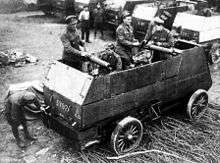Armoured Autocar
Raymond Brutinel

The Armoured Autocar was developed by Major Raymond Brutinel, who immigrated to Canada from France. Brutinel, a Captain in the French Army Reserve, became a self-made millionaire in Canada prior to the beginning of World War I. At the beginning of the war, he promoted an idea to combine machine guns and mechanical mobility. Brutinel assured the Minister of Militia that he could raise a mobile machine gun unit with private funds. Raising units with private funding was a standard practise of the time. As Vickers machine guns were unavailable at the time, Brutinel travelled to the Colt Company of Hartford, Connecticut and placed an order for 20 Colt machine guns. He then travelled to the Auto Car Company of Ardmore, Pennsylvania to purchase delivery vans which had a reliable reputation. He then moved on to the Bethlehem Steel Company where he bought stocks of 9.5mm armour plate.

Design
Returning to Canada, Brutinel directed the design of the armoured bodies that would be mounted on the truck chassis. The end result was an open topped armoured box with an angled front plate and drop sides. The machine guns were pedestal mounted, capable of firing over the sides of the vehicle, and also able to be dismounted for ground use. The Armoured Autocar weighed 3 tons, had a crew of 8 and had a maximum speed of 25 mph.
On 15 September 1914, the Automobile Machine Gun Brigade, C.E.F. was mobilized, comprising the 1st and 2nd Sifton Batteries. The Establishment called for a Major (Brutinel), 9 other officers and 124 other ranks. At the time of mobilization, the Brigade was equipped with 8 Armoured Autocars, 20 machine guns, 8 trucks and 4 automobiles. Within the following year, a further 3 batteries named Eaton, Borden and Yukon, were raised with private funding which lead to the establishment of a second unit. The brigades moved overseas and while there was no mobile role for them in the static fighting of the time, they somehow managed to retain their armoured equipment.

Specification
On 16 May 1915, the units were redesignated 1st and 2nd Canadian Motor Machine Gun Brigades, C.E.F. Each consisted of A, B, C, D and E batteries. Each battery consisted of 8 Armoured Autocars and 12 specially designed light trucks. An individual Armoured Autocar carried 2 machine guns, ammunition, extra gasoline and enough food for 14 NCOs and men. A Section was made up of 2 cars under the command of a Lieutenant, and a Battery consisted of 4 Sections under the command of a Captain. In addition to the armoured vehicles, each brigade also included a Section of motorcycles with 51 scouts who operated as signallers and dispatch riders. The Armoured Autocars were to prove their worth in the German breakthrough of 1918. While Brutinel had envisioned the unit spearheading an advance through the enemy lines, they were to ultimately excel in the defensive role by utilizing their firepower and mobility.
Brutinel's Canadian Motor Machine Gun Brigades were the world's first specifically designed and equipped armoured units. That they ever saw the light of day was a direct result of the Minister of Militia of the day, Sam Hughes, who with all of his faults, was more open to the concept of mechanical mobility in combination with firepower than were the traditional army leaders of the period. It would be 20 years after the conclusion of World War I before the idea of armoured machine gun carriers would catch on with the British War Office. The one surviving example of the Armoured Autocar is held by the Canadian War Museum in Ottawa, Ontario.
Replacement
A normal " Ground " Vickers Machine Gun Crew consisted of 6 men.
# 1 was the gunner who also carried the tripod to the setup position.
# 2 was the belt feeder who carried the gun to the setup position.
#3 & 4 were in charge of the ammo boxes, cooling water and spare parts.
#5 was a scout and runner.
#6 was a range taker and spare body .
All men in the Crew were trained in all positions and could strip and reassemble the weapon blindfolded.
The cramped size of the Canadian Motor Machine Gun Autocars only allowed 3 men each for the 2 Vickers plus one driver and one officer who had the opption of using a Lewis Machine Gun mounted in front.
Each Car could carry 10,000 rounds .
Legacy
The Canadian Armoured Autocar is considered to have played a major role as an influence on later armored car designs such as American Half-Tracks like the M2, M3 and M5 vehicles used by Allied Forces during the duration of the Second World War. Imperial German Forces also adopted the Sd.Kfz 251, along with the Russian BA-30. Armored cars of the first world war are what most consider to be the predecessors to modern day light tanks, reconnaissance vehicles and armored vehicles/armored troop transports.
See also
References
- ↑ http://steel-chariots.22web.org/autocar.htm?ckattempt=1
- ↑ Chris Johnson
- ↑ "WW1 Canadian Armoured Autocar - Landships WW1 Forum". landships.activeboard.com. Retrieved 2016-02-23.
- ↑ "Changes in Industry - Canada's Total War in WWI". sites.google.com. Retrieved 2016-02-23.